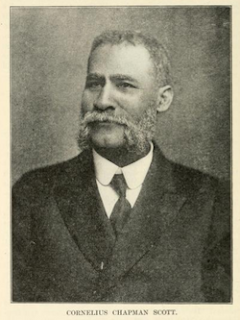 |
| Cornelius Chapman Scott From FindAGrave. |
South Carolina. Born free. Mulatto.
Occupation: teacher, preacher
Father's occupation: fan-maker
Cornelius C. Scott was born in 1855 at Fort Johnson, James Island, SC to Christiana and Tobias, free people of color. His father Tobias worked as a feather fan-maker. Two fans that Tobias made are in The Charleston Museum's collections. Both parents had been born into slavery but been freed. Christiana's mother had purchased her freedom, while Tobias bought his own freedom using personal earning from selling fans.
Scott grew up in Charleston. At age 13, he converted to Methodism and joined the Centenary Methodist Episcopal Church (an African American church founded shortly after the Civil War).
Scott was a student at the Avery Normal Institute and graduated in 1870 . He spent a year at Claflin University and then entered Howard University, attending from 1871-73 and graduating from the College Preparatory Department on June 16, 1873. When the University of South Carolina began enrolling African Americans students, Scott was visited by South Carolina State Treasurer Francis Cardozo who encouraged him to return to South Carolina, enroll at the university, and bring other students with him. Cardozo lent him $100 to cover travel expenses, and Scott returned with William M. Dart, John M. Morris, and Paul J. Mishow.
Scott registered as a student at the University of South Carolina in January 1874. He received a A.B. degree in 1877 and was one of the last students to graduate before the university's closure. His diploma was signed by the then newly elected Democratic Governor Wade Hampton III.
After graduating, he stayed in South Carolina and worked as a teacher, holding the position of "head teacher" at the Avery Normal Institute in Charleston and as principal at a graded school in Greenville. He was active in Greenville city politics. He served as head of the state lodge of the black Independent Order of Good Templars (a fraternal organization) for two years and was active in advocating for laws prohibiting alcohol sales. In 1889, he traveled to London, England as a delegate to the World's Sunday School Convention. While there, he met with British political leaders involved in the Temperance movement such as John Bright and Helen Bright Clark.
After 10 years of teaching, he entered the Methodist ministry. He worked throughout the state as a pastor, teacher, and newspaper editor. He edited and published one newspaper in Sumter, SC and one in Columbia, SC (The Southern Indicator)
Scott received several college degrees, although they appear to have been honorary. In 1891, he received an A.M. degree Ad Eundem from Syracuse University, and he later received a D.D. degree from Wilberforce University.
In 1911, The State newspaper published an article titled "The University of South Carolina: Abandoned by Whites – Negroes in Possession" that was highly critical of the admission of African American students during Reconstruction. In response, Scott wrote a lengthy Letter to the Editor of The State newspaper defending the conduct of the students and describing their later accomplishments. Summarizing the experience, Scott wrote:
One of the instructors has written me recently: "It seems now to have been an experiment, which like the whole early business of reconstruction, was founded upon a mistake. A pyramid set upon its apex will not stand.... We did what we thought to be our duty, and if we had our duty of '74 to do over again, we may not be able to any better." Any yet I feel that most of the students have by God's help made good, and that the State's money was not spent in vain.Scott died in Darlington, SC on November 18, 1922, and he is buried in Darlington Memorial Cemetery.
Sources:
1). "When Negroes Attended the State University", May 8, 1911. State (published as The State). Page 9.
2). "Alumni Record and General Catalogue of Syracuse University"
3). Biographical sketch published (1919) in History of the American Negro : South Carolina Edition : pp. 729 - 734.
1886=>joined South Carolina Conference at Anderson
1886=>Piedmont Circuit (conference appointment)
1887,1888=>Greenville Circuit
1889, 1890, 1891, 1892, 1893=>Spartanburg+principal of City Graded School
1894, 1895=>Sumter
1896, 1897, 1898=>Yorkville Station, Yorkville Colored Graded School
1899,1900,1901, 1902:Camden Station
1903, 1904, 1905, 1906: Camden Circuit=>Camden Graded School. First graduating school
1907, 1908, 1909, 1910=>Anderson
Cheraw
Columbia (2 years)
Darlington
Distrinct Superintendent of Bennettsvill>1919



No comments:
Post a Comment